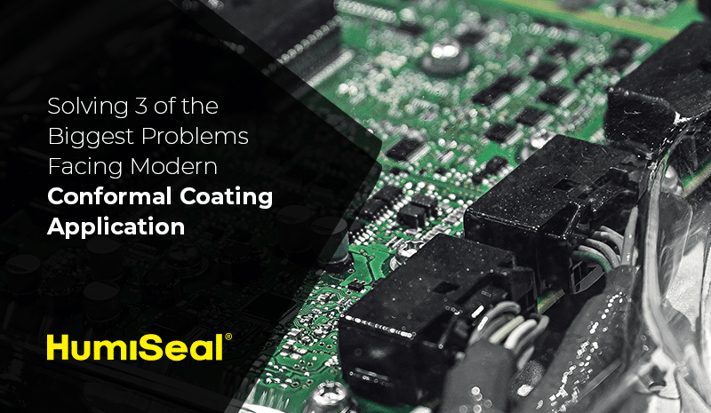
Conformal coatings have a long and storied history with printed circuit boards. A good conformal coating protects PCB components from moisture, corrosion, contaminants, and additional PCB threats like vibration and thermal shock. Coatings are a complicated science, and there isn’t one best coating or application method for every job. These choices are dependent on the design, use case, and assembly of the PCB. For instance, manual brushing PCB coating material is a slow, tedious process; but for small batch applications, it’s quite cost-effective.
Regardless of the chosen method, there are fundamental application errors that can occur, leading to defects forming in the coating which ultimately limit the functional service life of the PCB.
Most Common Problems in Conformal Coating Application
The printed circuit board industry is rapidly evolving. Just think of all the massive technological advancements we’ve seen in the last 30 years! PCBAs evolved at a similar rate. Through this evolution, we’ve noticed two significant trends that cause issues with conformal coating application.
- Components are becoming more intricate while also being subjected to more demanding performance expectations
- PCBs (and tech) are shrinking in size, causing the components to become smaller and placed far more densely
The second point makes conformal coating application incredibly challenging. As there’s less space to work with, the material properties of conformal coatings are limiting PCB performance. Coatings need to flow and distribute evenly across components, but the natural surface tension, adhesion, and cohesion of the material prevent proper distribution when space is tight.
This is just one symptom of an increasing problem. When we look at the issues that cause failures in design, we notice three specific pain points. In no particular order, they are:
- Bubbles forming in the coating
- Too much or too little coating spread around sharp corners
- Defects emerge during intense thermal exposure
These are the three major killers of conformal coating application. A natural question arises. How do we fix this?
Solving Common Application Failures for PCB Conformal Coatings
So how do we solve this? The short answer: science—a lot of complicated, boundary-pushing science. The HumiSeal research team is working tirelessly on the latest breakthroughs in conformal coating material science. This includes redesigning traditional application methods as well as working to create new and innovative conformal coatings.
We’ve done extensive research on the matter. It’s only natural as we are the initial inventors of conformal coatings. The details are far too complex to discuss in this blog. That said, Chris Brightwell, our Head of Development, has put together a tremendous research paper outlining the experiments and results found in our latest push to address these challenges. We encourage you to read the document at the link below.
UV Curable Coatings for PCBs
Growing bodies of research show promise for UV LED curable conformal coatings. In dealing with the sharp component edges, fast-curing coatings have an advantage as they solidify before the liquid flows to the base of the component. As such, they hold their intended shape nicely.
We recommend UV-curable coatings over other fast-curing coatings (like two-part coatings) due to the ease and relative lack of specialized machinery. Two-part materials often require specialized mixing stations and heavy preparation. UV-curable coatings are not without their downsides. They typically require multiple layers of application due to the limited penetration of UV light through the material. However, there is hope.
UVA spectrum light waves have shown far greater ranges of penetration, allowing for thicker layers of conformal coating application and curing. Additionally, UVA curable coatings show far greater thermal shock resistance and physical stability. These are not the only new coatings in development.
Related Article: Calibrating a UV Oven for Conformal Coatings
Sharp Edge Coverage Coatings
One of the latest breakthroughs in conformal coating science comes in the form of Sharp Edge Coverage (SEC). This new brand of coating tightly adheres to sharp component corners. This creates a more even coating distribution than ever before, reducing cracking when the material is too thick or seeping around corners, ensuring that every bit of the component is sufficiently protected.
Conclusion
The world of conformal coatings is evolving to meet the ever-changing requirements of PCBs. This is an iterative process; and as such, it’s important to stay up to date with the latest developments. The best way to do so is to sign up for our mailing list, ensuring you get the latest news and articles the moment they break.
As a supplier of all major forms and chemistries of conformal coatings, Chase Corporation and HumiSeal® can help you with an unbiased approach to evaluating your application and process. We’ll show you how to maximize efficiency, minimize cost, and improve product reliability. Our outstanding manufacturing and technical support groups can provide your organization with reliable global supply, unmatched quality, and superior technical support.
Please contact us today to discuss your application.









